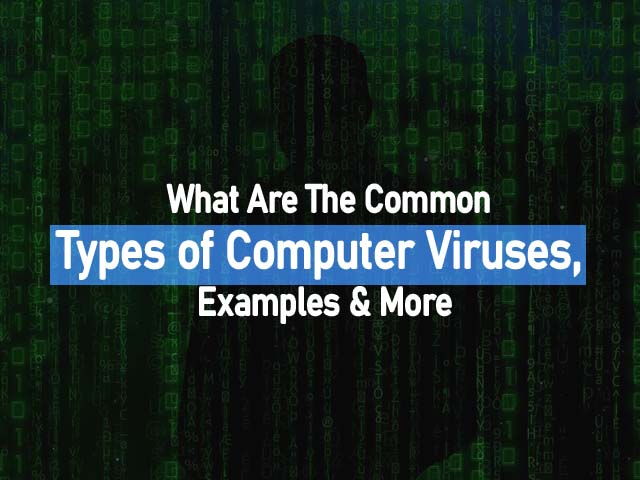If you consider yourself as a system, would you be able to do your activities properly if you are ill? Probably not right? Similarly, if your computer or system gets a virus, it also won’t be able to perform as expected and might show weird behaviors.
In many cases, if our computer is infected with some kind of virus, it may show some unexpected behavior, which may help you in identifying “ok… I think my computer is infected…”. Just like many times, some common types of viruses may infect us humans, and there are some common types of viruses, which affect computers.
Common Types of Computer Viruses, Examples & More
On a serious note, there are many common types of viruses that you need to be aware of so that you can take preventive measures because here, literally prevention is better than cure. So, in this article, we are going to have a look at some common types of Computer Viruses, so let’s get into it.
What is a computer virus?
If you are someone who’s not so familiar with the thing called computer virus, then this is for you. If you think you already know about what a computer virus is, please feel free to skip this part, and move ahead with details on different types of Computer Viruses. But I would recommend reading through this because it’s around a couple of minutes of reading.
So, a computer virus can be considered as “malicious software, which infects your computer/system, spreads across the system, and potentially damages your device or data, or even exploits your system for unwanted actions.”
Well, the definition gives a quite blurry idea of what might go wrong in this case, but let’s try to make sense of the above definition through some keywords –
- Infection
The viruses can attach themselves to documents, executable files, etc, which allows them to spread across the system. - Replication
When the virus is activated, it can replicate itself, and keep on infecting the system. - Exploit your device
Well, when a device is infected, it may be exploited by the attackers for several unwanted activities, which might range from just asking for a ransom, to making your device a medium to target more devices.
Well, reading that might seem a little bit scary, but one may find it hard to relate unless something happens to him/her. But you need to have a realization before it happens so that you can take all the possible preventive measures against it.

Different types of Computer Virus
Now it’s time for us to discuss some different types of computer viruses. First of all, let’s have a quick look at some types of Computer Viruses, that we are going to discuss ahead.
| Type of Virus | Description |
|---|---|
| File Infector Viruses | These viruses attach themselves to executable files and infect other programs when executed. |
| Boot Sector Viruses | Target the boot sector of storage devices, spreading when the infected device is booted up. |
| Macro Viruses | Infect macro-enabled documents and spreads through macros within these files. |
| Polymorphic Viruses | Change their code to avoid detection, making it challenging for antivirus software to recognize. |
| Resident Viruses | Embed themselves in system memory, allowing them to operate and infect files in the background. |
| Multipartite Viruses | Combine multiple infection methods, infecting both files and boot sectors for propagation. |
| SpaceFiller Virus | It fills in the empty spaces within the file with viruses. |
Now, let’s have a look at the different types of viruses one by one –
File Infector Viruses
File Infector virus, as the name says, does the job of infecting files. First, it inspects a single file and then spreads it into other executable files and programs. In short, they simply replicate and spread, but some of them may also damage the host programs, and even overwrite them. Usually, this is done with the intent of damaging the files, leaving them unusable.
Examples of File infector Viruses include Jerusalem, Cascade, etc.
Boot Sector Viruses
From the name you can probably get it, this type of virus has to do something with the Boot sector. So, this is the type of virus, which infects the boot sector of the floppy disk, or the Master Boot Record(MBR) in the hard disk. If you don’t know about the Boot sector, it has all the files required for starting the operating system.
This virus executes when the computer tries to start from the infected disk. The infected machine then often refuses to start(Goosebumps Loading).
Examples of this type of virus include – Stoned, Michelangelo, Elk Cloner, Angelina, etc.
Macro Viruses
If you have heard about Macro, you would relate to it. Macro virus is a kind of virus that is written in the Macro language used to create software programs like Microsoft Excel, or Word. Well, the thing is that it doesn’t depend on the Operating system, hence it may be able to infect systems running any kind of Operating System.
Examples of this type of virus include – the Melissa virus
Polymorphic Viruses
Polymorphic viruses can be understood as complex file infectors, which are tough to detect. Sometimes, it is also referred to as a metamorphic virus, and it repeatedly mutates itself and uses different encryption keys every time to vary every time.
Examples of Polymorphic viruses include URSNIF, VIRLOCK, VOBFUS, etc.
Resident Viruses
As the name says, resident virus means the virus that hides and stores itself in the computer memory. It may be able to infect any file run into the computer, and even the antivirus, so it may be able to infect every file scanned by the antivirus then. It is harder to remove it from the system.
Some examples of the Resident Virus include – Jerusalem, CMJ, etc.
Multipartite Viruses
A multipartite virus can attack your boot sector, as well as the executable files on an infected computer. In short, this type of virus can infect your entire system, spreading by performing unauthorized actions on your computer system, the folders, and the programs.
Examples of the multipartite virus include – Flip, Invader, etc.
Spacefiller Virus
This type of virus fills in the empty spaces in the file with viruses. It is also known as a cavity virus and is a somewhat rare form of virus for the computer. However, it might turn out to be potentially destructive for the files and the system.
Examples of such types of computer viruses include – CIH (also known as Chernobyl or Spacefiller)
A fun case study
I just want to tell you a small case study about a very interesting Computer virus, named ILOVEYOU. It was created by Onel de Guzman, a student from the Philippines, who was struggling to pay for the internet, and so he created the virus to steal passwords from people to use the internet for free. The virus originated on 4 May 2000, and after that, it affected over 10 million Windows PCs.
The virus had spread through email attachments with the subject line “ILOVEYOU”, and it had the file name LOVE-LETTER-FOR-YOU.txt.vbs.
As you may have guessed from the file extension, the virus was written in a visual basic script (VBS), and it had exploited a feature from Windows, which hid the real file extension from the users.
This virus caused a variety of damages to the infected machines and resulted in disruption of operations in many businesses and government agencies.
However, since there were no laws against malware creation in the Philippines at that time, the creator was not prosecuted for what he did. But just see, how it started from stealing the passwords to access the internet for free, ending up infecting millions of systems, and disrupting the operations at many businesses and government agencies.
Moral of the story: You shouldn’t be opening such files, and files from some unknown sources, which may provide an entry point for the attacker.
Conclusion
We discussed different types of computer viruses, like some common types of viruses. Although there’s more to explore about these and more viruses, I think this stands as a good entry point for putting the virus in you, which would allow you to explore more about computer viruses (Just kidding, but this was my way to encourage you to explore more about computer viruses).
We also saw an interesting case study about the ILOVEYOU virus, which ended up infecting millions of systems and had started with just the intention of stealing passwords for free access to the internet.
You can explore more about computer viruses, particularly in the cyber security field, and you can also read more about some other interesting case studies, which give us an idea of the extent of the cyber attacks.
FAQs related to Common types of Computer Viruses
Ans: Creeper virus is most commonly recognized as the first Computer Virus. It was created as an experimental self-duplication program by Bob Thomas.
Ans: Many types of viruses are common in Computers, like File infecting viruses, Boot sector viruses, resident viruses, and so on.
Ans: A computer virus can be considered as a malicious program, that is intended to infect the system, and potentially cause damage to the system and data.




